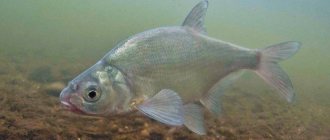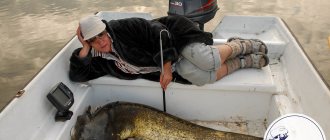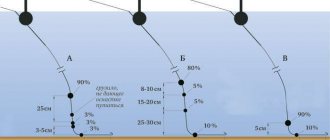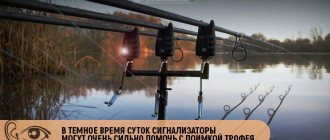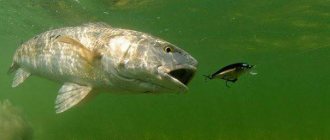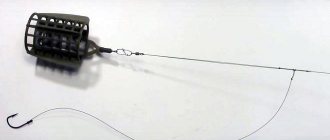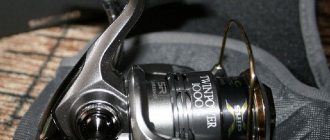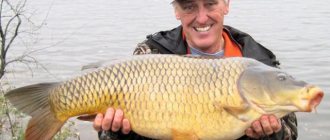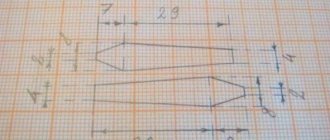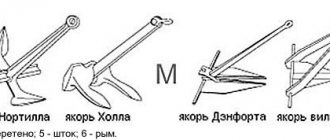The topic reveals a method for setting up an onboard bottom fishing rod for active and passive fishing. Photos of nods most suitable for summer fishing from a boat are shown. Links are given to technical processes for the independent production of shock absorbers - bite alarms.
At the end of the page, those interested can get acquainted with the attachments most often used for fishing with side rods. The design of the cut presented in the topic was first tested on fishing from a boat about forty years ago and serves faithfully to the present day.
Setting up an onboard bottom rod
Setting up an onboard bottom fishing rod comes down to selecting the mass of the sinker and the elasticity of the bottom nod spring.
Typically, setting up the equipment begins with a sinker, the weight of which in the water is selected in accordance with the depth of fishing with an onboard bottom fishing rod, the strength of the river current and the thickness of the main fishing line.
The more significant the factors listed above are, the greater the weight of the bottom sinker in the rigging of the onboard bottom fishing rod should be.
But at the same time, the sinker should be carried at least a couple of meters from under the side of the boat, especially when fishing with a bottom rod in shallow areas of reservoirs. Therefore, when setting up the equipment, you should not place too heavy a load.
In addition, the sinker of the side bottom fishing rod should noticeably knock on the bottom, so it is undesirable for it to be noticeably lifted by the current. Knocks on the ground and the most careful fish bites should be clearly recorded by a signaling device.
Therefore, when setting up the equipment of an onboard bottom fishing rod, special attention should be paid to the reaction of the nod to a fish bite. The most sensitive will be a nod, the spring of which is adjusted (extended) at a right angle to the line of the bottom fishing rod leaving the side of the boat into the water.
All of my bottom side fishing rods, designed for catching fish of the carp family, are configured for fishing with nods with metal spring shock absorbers of a certain degree of elasticity. Therefore, the entire adjustment of the nod for the best fixation of fish bites comes down to changing the bending arc of the shock absorber spring.
Without the influence of the weight of the bottom fishing rod, the shock absorber spring should be bent upward.
Donk fishing technique
It will be somewhat more convenient for a fish such as bream to pick up prey from uneven areas of the bottom surface topography than to feed on fairly flat surfaces.
Therefore, the angler should take this fact into account when fishing for bream on currents using boats. Therefore, it is important for this type of fishing to initially determine the location of the edges on the river bottom, the location of the holes, and the depth differences on the river. In addition, it will take a little longer for the fertilizing agent to be washed out of the drops and holes.
When fishing from a boat on rivers, you should take a position that is not located on the channel dump itself, but away from it. If the fishing is carried out on small rivers, the fishing is carried out in such a way that the fishing can be carried out on both sides of the boat itself.
At night, this fish can successfully search for its prey in shallow areas of the river, and therefore catching bream in these areas will be successful.
Having determined the fishing area, you should carry out the process of feeding the bream, wait a little while, about twenty minutes, and start fishing. The process of additional feeding is carried out no earlier than every thirty minutes.
Fishing for this fish does not require particularly sharp jerking movements, especially when fishing from a boat. Therefore, try to behave calmly, the presence of landing nets will greatly simplify the matter.
Tips for beginners
- When catching any fish, the feeding process is important; it is better to slightly underfeed the fish.
- It is worth remembering that the presence of predatory fish species can scare away the bream itself from feeding.
- If it is noticed that the bream has approached the bait and is actively devouring it, which can be seen from the air bubbles, but does not respond to the bait, then you should change the bait.
- If the process of hooking a bream is carried out, you should immediately try to move it away from the feeding point so as not to scare away the remaining individuals of this fish.
- If the fish suddenly stops biting, this indicates a change in weather conditions.
Experienced anglers often catch fish using several donk gear. Firstly, this increases the chance of catching as many fish as possible, and secondly, it allows you to occupy a considerable area of the coast.
A rod and reel are securely fastened on the shore, since fish usually bite sharply, and this can lead to an unsecured reel going into the water. If possible, the fishing line is secured to snags or trees.
It is better to give preference to bodies of water without algae, snags and rocky bottoms. In such places, hooks will be constantly carried out, and this threatens to break the gear. Suitable times for donka fishing are morning, evening or night.
When all the preparatory procedures are completed, it’s time to set sail. When a suitable fishing spot has been found, you need to anchor the boat.
The best way to do this is to use a couple of anchors. If you plan to fish in a small current and use a large feeder, then you can get by with one anchor.
After the boat is anchored across the current and the feeder is lowered to the bottom of the reservoir, you can proceed to fishing.
We fasten the ring to the cord from the feeder. We put bait on the hooks. After this, we smoothly lower the ring with the bait to the bottom until it touches the lid of the feeder. Then we release a little of the main line so that the hooks are slightly carried away from the feeder by the current, tighten the line and wait for a bite.
The principle of fishing with a ring is quite simple - the current washes the bait out of the lid, the bream comes up to feed and gets hooked.
If the bite weakens, you can pull the feeder by the cord. This will agitate the bait in it and increase its leaching.
Active fishing with an onboard rod
One of my side rods, rigged for active current fishing, is shown in the photo.
The active method of fishing with a side bottom involves constant or periodic movements of the nozzle (bait) of the fishing rod along the current above the river bottom with simultaneous oscillations of the nod spring.
During periods of greedy feeding of fish, by manipulating the bait, we can significantly reduce the intervals between bites. To do this, you just need to actively “shine” the bait or bait in front of the fish, which may not be under the boat.
Often, a few swings of the spring of the nod of the side fishing rod or the tapping of the whip on the rubber side of the boat is quite enough to sharply activate the bite of the fish standing downstream.
For the active method of fishing, the load is tied rigidly to the main line of the onboard fishing rod, but not in a sliding manner. And in order to reduce the likelihood of the hook getting caught, the leash should be raised by the current above the bottom.
How to choose the best place to catch bream?
The most favorable time to go fishing with this gear is considered to be the period when the fish begins to actively feed on everything.
This is usually the period when schools of fish have already left spawning, at the beginning of summer and until the first noticeable cold snap in the fall. As soon as the water temperature drops, the activity of the fish decreases, and fishing using a ring loses its relevance.
The best place for fishing with this gear is considered to be a river bed with a fast current, where bream, carp and other carp families usually feed.
To quickly find fish, you can use an echo sounder, but the cost of the device is extremely high.
Therefore, when fishing for bream, every fisherman needs to know:
- Bream prefers to spend all its time in holes at a depth of 5-8 meters, in rivers with medium currents, but individuals can be found living at depths of over 10 meters;
- Bream usually looks for food at the very bottom of the reservoir;
- A characteristic sign of the presence of bream is small bubbles rising from the bottom when the fish surfs the bottom in search of shellfish and other food;
- If you find a similar place, you should not immediately cast your fishing rod; you need to feed the fish, but this will be discussed later in the article.
In practice, bream are usually caught at a specific time for the chosen fishing location. On the same body of water, the bite time may vary; in one place a good bite occurs in the morning, in another after lunch, or late in the evening. All this is worth considering if you don’t want to return home empty-handed.
Game of onboard bottom fishing rod bait
Active play with the bait is possible because the load in relation to the fishing line with the leash of the onboard bottom fishing rod is on a stretch. And the rigid fastening of the load at the end of the main tackle allows them to be manipulated.
With the active method of fishing, the sinker of the side bottom fishing rod is periodically driven along the river flow, then pulled towards the boat.
The bait also “walks” along with the load. At the same time, the fish standing downstream can not only see the bait on the hook of the tackle, but from afar they can also notice a cloud of turbidity raised by the blows of the sinker into the bottom of the reservoir.
It is clear that active fishing with onboard bottom tackle from a boat is possible with only one fishing rod. But the catch with this method of fishing can far exceed our expectations.
Spinning fishing
This type of fishing in the current from a boat also requires the use of an anchor and the choice of location. As a rule, they fish from a boat with a spinning rod no longer than 2.1 m, since it is much more convenient to maneuver, and there is no need to make a super long cast - you can swim up.
- The spoon is cast both along the current and across and up. When casting downstream, the bait is slowly reeled in, with short (5-7 seconds) stops. When throwing the tackle across, we do it at an acute angle downstream.
- When throwing a spoon upstream, remember that it will definitely be carried away. In such cases, you can let the spoon lie on the bottom, and then start retrieving. The main thing is to fish the selected area as efficiently as possible.
- After 5–7 casts in each direction, you can change the location. Operating in this way, it is almost impossible not to find fish. This is the advantage of the boat. Remember that determining the bottom topography is the main task for a spinner. If you manage to find a hollow or underwater ridge, you will not leave without a trophy.
Bottom rod attachments for current
The most popular summer baits and baits for fishing from a boat with side bottom rods along the river are shown in the picture.
These are worms, maggots, boiled pearl barley grains, rather firmly attached to the hooks of bottom gear.
In case of rare fish bites, one of the attachments suggested above can be constantly activated, causing it to oscillate with a nod spring. Then the bait becomes much more noticeable in the muddy bottom water of the river. As a result, the results of fishing with side bottom rods from a boat significantly increase.
The swing amplitude of the nod spring can be 5-7 (or even more) centimeters; frequency - 60-80 times/minute. Without going into details, I can say that the nozzle at the bottom will move along the current by a very small amount.
Although in the summer, on summer fishing trips in hot weather, I catch bream, roach, white-eye, blue bream, and silver bream with bottom rods from a boat on river currents using vegetable baits - not liquid batches of brewed semolina, or even simply mashed baked goods with flavorings.
But these will be summer baits that are weak on the hook, quickly washed away by water flows, and are not very suitable for fishing from a boat with bottom gear on more than noticeable river currents.
In any case, after each empty bite you have to check the safety of the soft bait on the hook of the bottom fishing rod.
If you are more interested in fishing from a boat on weak river currents with baits of plant origin, then I recommend that you familiarize yourself with the summer fishing tackle, which is one of the types of onboard bottom fishing rods during summer fishing.
Side fishing rod with wooden handle
An onboard fishing rod with a wooden handle for catching fish from the bottom of the river and the elements of its equipment you can see in the photo. I use the same gear to fish from ice in the winter.
One of the advantages of onboard fishing rods with a wooden hollow handle is the predictable unsinkability of the gear.
The fisherman can take advantage of the second undoubted advantage of a wooden container himself if he thinks through the correct layout of the onboard fishing rod, the hollow handle of which can accommodate end equipment of any configuration.
To do this, the leash with the hook and sinker of the bottom tackle is not tightly wound onto a small reel, cut from hard foam, and then placed in the cavity of the wooden handle of the side fishing rod.
The nod spring holder is usually located directly under the plastic cover. And there has never been a case where the equipment of an onboard fishing rod, being in this form in a hollow wooden handle, got mixed up.
However, these fishing rods also have two significant drawbacks: very fragile plastic caps on fairly durable wooden handles and too short for an onboard hooking rod.
Therefore, immediately after purchasing such a fishing rod, it is advisable to strengthen the cap with several layers of electrical tape, and for the convenience of fishing from the side of a boat, you should at least make another longer whip from vinyl plastic.
***
Source: 99ll.ru
In the middle reaches of the river, you can catch almost any fish using a donk from a boat. And catching bersh and pike perch on a donka is a common thing. They often bite ide, sopa, sabrefish, roach, and sometimes there is simply no end to the silver bream.
Quite often, carp are purposefully caught with a donkey in the shallower, meadow part of the reservoir. Catfish are often caught, but not all of them can be pulled out. In autumn, burbot is occasionally caught on the bottom. But all these fish are only bycatch to the main object of hunting - bream.
WHEN AND WHERE TO FISH
Donka fishing from a boat is usually practiced on large navigable rivers and reservoirs. Many anglers associate it with fishing on the riverbed slopes, near the navigable fairway. And indeed, most of the bottom fishers catch on the riverbed - there are more fish here, and the current is stable even on weekends, when the floodgates are usually closed.
For fishing from a boat, choose deep areas of a river or reservoir that are inaccessible for fishing from the shore.
Fishing from a boat can be effective not only on the riverbed, but also on deep-water oxbow lakes and on the shallower, meadow part of the reservoir. However, at different periods the bream sticks to different places on the reservoir. And knowledge of these sites is key to a successful fishing outcome. Donka fishing begins immediately after the bream “gets sick” after spawning - this is the beginning of June, when the fish are actively feeding and are caught almost everywhere in deep water.
Bream fishing can be successful on the right bank of the riverbed or, as our fishermen say, on “rocks”, on oxbow lakes or some other deep ditches, as well as in meadows. On the bed and ditches of a river or reservoir, they try to find 11-13-meter edges. It is in such places that it is most convenient for bream to get food. In the meadows, the boat is placed above depths of 8-8.5 m, also trying to feel for any unevenness on the bottom: either a slope or an underwater tubercle.
The intense bream bite continues for a couple of weeks, and gradually worsens as July approaches. But even in July you can count on a good catch. As the water warms up, bream moves to deeper places, and at this time it is caught mainly at depths of more than 10 m. In mid-July, when the water blooms, the bite worsens. This is perhaps the most unfavorable period for donkey fishing. In warm water, fish are passive due to a lack of oxygen, which is absorbed by single-celled algae, which cause water blooms. The bream itself readily feeds on them, which also worsens the bite.
The fish become active in August. At this time, bream gathers in large schools and feeds intensively, preparing for the upcoming winter. Moreover, for the most part it is concentrated on the left (meadow) bank of the riverbed. At this time, fishing can be very productive, but, as a rule, the fish caught are small, up to 1 kg. Closer to autumn, schools of bream migrate to wintering pits.
The most productive fishing occurs in the morning and evening dawns. Catching a large bream is more likely in the morning - it all depends on the flow regime. At the beginning of fishing, up to about six o'clock, usually a fairly strong current washes the food out of the feeder well. Then it gradually weakens, and by nine o’clock it may stop completely. You can count on a bite from a large bream when the strong current weakens, when it approaches hooks with bait along the path of washed-out food.
In the evening everything happens exactly the opposite. You get up to the spot at about five in the evening, at this time there is usually no current or it is quite weak, so the bait is not washed out of the feeder well. As evening approaches, the current gradually intensifies. Catching large bream is most likely when the current is moderate or weak. In the evening the biting period is quite short, since around eight o'clock the current usually becomes very strong. In a fast current, as a rule, smaller fish are caught; large bream tries to find shelter behind some irregularities on the bottom. But there is an exception to this rule: catching large bream can be successful even in very strong currents.
GEAR AND EQUIPMENT
Any boat is suitable for donk fishing: a duralumin boat, a yawl, or a rubber “inflatable” can be equipped in such a way that it will be convenient to fish. For fishing you will need a strong nylon or synthetic rope with a length of at least 60 m, two reliable anchors for setting the boat on guy ropes, a feeder in the form of a mesh bag, a depth gauge, a fish tank, a net, fishing rods and a supply of necessary equipment. I will dwell in more detail on the feeder and equipment.
The feeder used for bottom fishing from a boat is quite voluminous. The mesh size of the mesh depends on the strength of the current and bait. If the feeder is filled with bread, then a mesh with a larger cell is chosen for it; if it is filled with porridge, then with a smaller one. The average mesh size is 5-7 mm. A lead weight in the shape of a pancake weighing at least 300 g is placed in the feeder. The feeder is tied to a fishing line with a diameter of 1 mm and a length of about 30 m. The choice of equipment design depends on the fishing conditions, primarily on the strength of the current. The most common one is shown in (Fig. a), let's call it “ordinary donka”.
a – regular line: 1 – main line D – 0.35-0.4 mm; 2 – triple swivel; 3 – a piece of fishing line with a sinker; 4 – main leash; 5 – side leads; 6 – hooks;
An ordinary donka consists of a main line with a diameter of 0.35-0.4 mm; a triple swivel, which serves to attach the leash to the main fishing line (you can tie the leash directly to the fishing line without a swivel), as well as a piece of fishing line about 15 cm long with a sinker. I tie the fishing line to the swivel using the “loop-to-loop” method, and slide anti-twist bars onto the fastening nodes—4-centimeter pieces of cambric with an internal diameter of about 1 mm.
As sinkers for all rigs, I use lead rings with a slot weighing 30-35 g. I tie side leashes of the same diameter, 15-20 cm long, with hooks to the main leash with a diameter of 0.27-0.3 mm. The distance between the side leashes is 1 m. Usually three hooks are placed on the equipment, but their number can be greater, then the main leash is made longer.
If the weight-ring of an ordinary donkey is placed on a fishing line 1 mm thick and lowered onto the feeder (Fig. b), you will get a very catchy equipment, which is called a “ring”.
b – “ring”
It gives good results when fishing in strong currents, since the hooks with the nozzle are located exactly above the narrow trail of bait coming out of the feeder. A bream following the trail of bait against the current will definitely come across hooks with bait.
(Fig. c) shows a “button” donkey rig, the main leash of which can be lengthened depending on the strength of the current.
c – “button” bottom: 1 – main line; 2 – button; 3 – fishing line with a sinker; 4 – main leash; 5 – stopper;
The main fishing line is passed through one of the holes in a regular button. In this case, the main leash is a continuation of the main fishing line. A piece of fishing line with a sinker is tied to another hole in the button. A stopper is placed on the main leash, the distance from which to the far hook depends on the number of hooks on the rig.
Why is such equipment needed? The fact is that in a strong current the fish are usually not located at the feeder itself, but at some distance from it, downstream. If you fish with a regular donkey, then only a distant hook works in this case. Using a “button” rig, you can wind a couple of meters of fishing line from the reel of the fishing rod, then the main leash with hooks will move the same distance downstream. In this case, all the hooks with the nozzle will be in the “working” zone, that is, where the fish is. When the current weakens, the exhausted supply of fishing line is wound back until the stopper rests on the button, and fishing continues with a shorter leash, as on a regular donka. At this time, large fish, as a rule, come closer to the feeder.
When the current stops completely, long leashes begin to get tangled, which makes fishing much more difficult. Then it is better to use the equipment shown in (Fig. d).
d – equipment for still water: 1 – main line D – 0.25 mm; 2 – sliding sinker weighing 10-15 g; 3 – stopper; 4 – leash; 5 – hook.
It consists of a main line with a diameter of 0.25 mm, a sliding sinker weighing 10-15 g, a stopper, a leash and a hook. The leash is a continuation of the main fishing line. The stopper is a centimeter-long piece of soft and thin cambric (usually black) with an internal diameter of about 1.5 mm, pulled together into a knot on the main line. The stopper is installed as follows. A sliding sinker and a cambric are threaded onto the main line. 30 cm from the leash, the cambric is fixed with two overlaps of the main fishing line and pulled into a knot (Fig. d, enlarged).
The handle of a fishing rod is made of either wood or hard foam. A whip made of fiberglass, which is very strong and flexible, is perfect, but you can also make it from vinyl plastic, which, however, is inferior to fiberglass. The nods are chosen to be flexible, sensitive, of such a diameter and rigidity that they are not bent too much by the current. Silicone nods have these properties. You can attach a reel to the handle of the fishing rod, but, in my opinion, it is more convenient to use a reel. 40 m of main fishing line is wound on a reel (reel). It is most convenient to use a cage knitted from nylon thread with a long neck. The net should have a large round rim and a deep net designed for large bream.
BAIT AND BAIT
The success of the upcoming fishing largely depends on the bait. I never use ready-made mixtures, but use crackers and boiled cereals: pearl barley, oatmeal, wheat, peas. Bream, especially large ones, love steamed wheat. Ide, roach, and carp prefer large grains, so if the angler is aiming to catch these fish, steamed pearl barley and peas should predominate in the feeder.
It is very effective to feed the fish with boiled rolled oats flakes, which, when washed out of the feeder, form an appetizing cloud. Even cooked pasta is suitable for bait. The main thing is that all ingredients are fresh.
The traditional bait for catching large bream is a worm. Our fishermen conducted experiments with worms and found that at different times bream prefers different worms.
I put several of them on the hook, so the hook should have a long shank. For fishing with a worm, hooks No. 8-10 according to the domestic classification are suitable. A “sandwich” of red worms and white “ironworms,” as well as several worms and maggots, can be very catchy. There are cases when a large bream completely refuses the worm and takes only maggots, and only small things are caught with the worm. For maggots I use hooks No. 7-9 with a short shank, usually white or yellow. As for vegetable baits, I often use steamed pearl barley grains. White hooks with a short shank are also suitable for this bait. Pearl barley grains should be soft and not interfere with reliable hooking of fish.
TECHNIQUES AND TACTICS OF FISHING
The primary task of the fisherman is to find a promising fishing spot. The most catchy ones are usually all kinds of irregularities on the bottom: edges, slopes, tubercles. Many fishermen, having found a fishing spot, place a drawbar with a feeder on it, constantly attaching the fish to the fishing spot. When installing a constriction, you do not need to constantly carry a rope with anchors with you. Having arrived at the place, the fisherman hooks the constriction with a grappling anchor, lifts it to the surface, ties the boat to it and fishes in the already baited place. However, the tug also has a drawback - it “ties” the fisherman to only one fishing spot.
If the haul is not used, the angler, having found a suitable place, stands on the guy wires. After this, you need to prepare fishing rods and baits, lower the fish tank overboard, and put the feeder on the bottom and remove all unnecessary things. Equipment is selected depending on the strength of the current. If the current is strong, then they usually place one donk on the “ring”, and the other is simply lowered next to the feeder.
Some fishermen put several tackles at once, without fear that the rigs will get tangled, since their long leashes extend strictly with the current. If it is strong, you can put two fishing rods on the “ring” at once, and lower two feeders accordingly.
A capacious landing net should always be at hand. If there are no bites for a long time, you can move along the rope and stand either in a shallower or deeper place. It is recommended to shake the feeder from time to time, this can also attract fish and activate the bite.
During the period when the current weakens, most bites of large bream occur. However, when the current stops completely and the long leashes of the fishing rods often overlap with each other and with the feeder, many anglers leave the fishing spot, not realizing that they can double or even triple their catches in this situation.
A completely different fishing begins, more sporting and no less productive. The fish walks along the path of washed-out food straight to the feeder. Thus, fishing takes place under the boat itself, so you need to be as quiet as possible. Large bream does not tolerate noise. The thin sliding equipment shown in (Fig. d) does not alarm large fish, and bites on such equipment are very confident.
The main bait for fishing without current is steamed pearl barley. The more pearl barley porridge there is in the feeder, the more confidently the bream bites on it. Several grains of pearl barley are placed on a hook, completely covering the shank and the hook tip. While fishing, you can play along with the tackle by swinging it several times. If the fish is somewhere nearby, then a bite follows almost immediately.
The hook should be sharp and sweeping, especially if fishing occurs in a strong current. After hooking, you need to quickly pick up the slack in the line, as it “bends” with the current. Even if you feel that the fish has not been detected, you need to remove the equipment from the water, check the nozzle and, if necessary, replace it.
The bream offers resistance only at the first moment. After it has been pulled away from the bottom, it goes to the surface quite calmly, and after taking a breath of air, it completely pacifies. It’s another matter if there is a carp, ide or catfish on the hook. These fish resist to the end and often win a fight with the fisherman, but despite this they give him a lot of pleasure.
Donka fishing from a boat is interesting for the angler because he observes even the most cautious bites in close proximity to himself. Donka is also attractive because it catches truly trophy fish.
Source: www.vseofishing.net
Tackle for donkey
Rod and its equipment
When planning to go fishing with this gear, you need to worry about a strong fishing rod; the length of the rod should be no more than one meter. The main thing is that the rod fits comfortably in your hand.
You also need:
- Passing rings;
- A reel with a line reserve of 35 to 70 meters.
Ring
This essential element of fishing gear has a large number of design modifications, but it is best to choose the classic design. The ring is usually made of lead with an approximate diameter of 30-40 mm. or a little more depending on the fisherman’s preference.
A cut is made in the circumference of this ring, which serves to thread the cord and drill a hole for installing the fishing line.
Do not tie the leashes tightly, as the tackle may lose its sensitivity. Which will help you see the bite in time.
Feeder
For a small current, a mesh feeder is suitable. A load of up to 3 kilograms must be placed inside. You can also use a plastic feeder if the bait is heavily washed out. And it is advisable to use colors similar to the fauna of a given body of water.
The best choice would be a feeder made of material that retains odors for a long time to attract fish efficiently.
It is better to choose an inflatable boat. So that if necessary you can move it.
When fishing for bream, you need to prepare the following components:
- Line with a diameter of 0.30-0.45;
- Side rod;
- Nod;
- Ring;
- Two or four hooks;
- Line with a diameter of 0.8-1.5;
- Feeder;
- Weight for the feeder.
We install the fishing line to the fishing rod and make a loop about 10-15 cm and attach the ring. Next we prepare the leashes. They can be secured with carabiners for quick changing and adding new leads. There are two types of fasteners for the leash to the fishing line: tight and sliding.
In this case, the leash is placed at 110-130 cm with a pair of hooks or more. The best solution would be hooks for bream and other carp fish. This will add convenience to bait placement and ease of removing caught fish from the mouth.
Hooks
Particular attention should be paid to hooks. They must be sharp, only then will they last a long time and prevent the fish from escaping. A well-sharpened hook should slide easily over the nail when passed with the tip.
After making all the necessary manipulations with the tackle, you can start fishing.
How to prepare a feeder for bream fishing?
Fill the bait mixture as follows:
- First you need to attach a weight so that the feeder does not float;
- Behind the load comes the bait itself, which is laid tightly enough so that it does not fall apart ahead of time and at the same time you will have to make sure that the bait is not too compacted;
- Next, you need to carefully close and attach the feeder to the cord;
- Release the feeder to the bottom.
Preparing to install the ring for fishing
- Take the fishing line and thread it through the ring, into a special hole.
- Install the ring on a cord or thick fishing line to which a feeder with bait is attached;
- Release all the tackle into the water, make sure that the line does not twist or overlap the cord;
- The leashes should be placed a little further from the feeding area.
Do not allow the bait reel to unwind the line excessively.
Ring fishing has long become the most common and popular way of fishing on the Volga. Because of its accessibility and simplicity. The most fishy places are considered to be places near Astrakhan and from the village of Promyslovy to the island. Gusiny near Baranovka.
Helpful Tips:
- Do not forget that bream is a very cautious fish and therefore the lid of the feeder should preferably not be made of metal materials, in order to avoid loud sounds;
- It is very important to securely secure the load on the feeder to hold it firmly at the bottom, otherwise the complementary food may bounce on the rocky bottom;
- The bait can be very diverse, bloodworms, worms, as well as dough, bread and other baits of plant origin.
- It is necessary to exclude contact between the ring and the bait; for this purpose, a special limiter is installed, installed 30-45 cm from the feeder itself.
- You can put a rubber stop on the cord of the feeder, which will stop the load and prevent it from getting caught on the feeder, which will simplify the moment of casting.
Fishing gives pleasure in its process - each of us knows this. But, besides this, we always want to get results from fishing - to catch not three perch, but a dozen kilogram pikes - what a catch! Each of us dreams of this, but not everyone can do it.
How long has it been since you had a really BIG CATCH? When was the last time you caught TEN HEAVY PIKE/CARP/BREAM?
A good catch can be achieved (and we know this) thanks to good bait. It can be prepared at home or bought in fishing stores. But stores are expensive, and to prepare bait at home, you need to spend a lot of time, and, to be fair, homemade bait does not always work well.
You know that disappointment when you buy bait or prepare it at home and only catch three or four bass? Of course it's familiar. So maybe it’s time to use a truly working product, the effectiveness of which has been proven both scientifically and in practice on the rivers and ponds of Russia?
Of course, it is better to try once than to hear a thousand times. Moreover, now is the season! A 50% discount on your order is a great bonus!
Order Fishhangri soon!
One of the popular gear for all carp fishing enthusiasts is the ring. Fishing using ring gear has proven itself well in reservoirs where moderate and fast currents prevail. The advantages of this device lie in its simplicity of design, reliability and accessibility to everyone.
At the first stage, you will have to collect bottom gear for fishing in the current.
- rod
- coil.
- leash.
- a fishing line with sinkers and fishing leashes with hooks attached to it.
After preparation, donk fishing begins. Some fishermen claim that it is not difficult to create such a structure yourself. You need to work on every element.
As a rule, a circle has a diameter of 13-15 cm and a thickness of 2.5-3 cm. Small circles are used for catching perches, large ones for hunting large predatory fish. Around the circumference of the mug there is a groove 8-10 cm deep for winding fishing line, and in the center there is a hole for a wooden pin. To secure the fishing line when installing the circle, two cutouts are made on its disk, which should not reach the groove.
It is advisable to make the disk of the mug from light wood, cork or foam and paint it in two colors: white (bottom) and red (top).
The pin should be 15-18 cm long and 1.2-1.5 mm thick. There should be a slot in its upper part, and a spherical head in the lower part. About 2/3 of the way down from the head, the pin should be cylindrical so you can lift it up and down.
Paint the thin end of the pin and 1/3 of its head black, the rest white.
For a good catch, you will need 5-10 circles, which should be installed at a distance of 4-5 m from each other.
To catch large predatory fish from a boat, it is best to use a track - a tackle made of a thick cord about 100 m long, to one end of which a metal leash with a sinker and a spoon is attached.
The second end of the cord is attached to a plywood board, onto which it is then wound. Sometimes a durable fishing rod equipped with a multiplier or a simple inertial reel is used for line fishing.
Boat equipment
If you are going to use this fishing method, you will have to upgrade your boat by equipping it with rod holders. You can use metal or plastic tubes of various diameters or buy special holders screwed to the sides of the boat.
Sheer donk from a boat
In the current, fishing for bream from a boat with bank tackle is a healthy alternative to conventional spinning donks. A heavier load and no need to mount long rods in the boat makes it easier to manage the gear. Bream likes to approach a fairly massive feeding table. The can holds much more bait, and besides, fishing is usually carried out with several tackles lowered from the side. In the current below the boat, a powerful trail of rushing food particles is created, to which fish approach - bream, silver bream, blue bream, any river whitefish. But this method works better for bream, since the feeding is voluminous and constant.
Fishing with a can is similar in principle to fishing with a ring - the equipment also has a volumetric feeder, and the leashes are pulled downstream by the flow. The bream rises along the feed stream and finds the bait on the hook. The egg rig is a continuation of the development of the ring. Instead of a lead ring running pivotally along the cable, two weights on a wire are used. When a large fish bites, this device flies off the feeder cable, and fishing takes place without the working equipment coming into contact with the feed. Read more about side donks.
Bank for bream (submission)
A can for catching bream is essentially a bottom bottom, in which the feeder is located on the main line according to the inline sliding principle. This is the ancestor of the ring and egg rig. In this form, the tackle is thrown in and taken out along with the feeder. On the ring and eggs, the equipment is thrown in and selected separately, sliding along the feeder cable, and the heavy feeder itself is not taken out (only occasionally, to replenish food). A jar is a space in which the feeder itself is made from the appropriate container. The most commonly used are coffee cans, but there may be others. Any jars with a volume of 300-500 milliliters will do. Read more about catching.
The bank donk is something average in caliber between ordinary donks with a spring and a ring. The bottoms have light weights that allow you to cast the rig with a fishing rod. The can is larger and heavier; it is lowered into the water by hand or with a rod without casting, just into the water from the side. The ring and eggs contain even more massive feeders, into which kilograms of food are stuffed. Therefore, they are installed for a long time. Each time the bank tackle is pulled out along with the feed, which is filled with bait. The principle is the same as in a regular spring, only the volume is much larger. And this is just good for luring bream.
The bait is filled into the jar, the consistency of which is selected individually depending on the strength of the current, the number and diameter of the holes in the feeder. It is necessary to achieve such a ratio of the holes in the jars, the stickiness of the food and the strength of the current so that the bait is completely washed out in about 30-40 minutes. The bait is prepared depending on the preferences of the bream in a given reservoir. It can be porridge, store-bought mixtures - it doesn’t matter. Traditionally, jar makers mix millet or pea porridge with dry mixtures, ground cake, and breadcrumbs. Read more about proper bait for bream.
Bait and baits
Features of bait for bream:
- For large individuals, make bait with the addition of large particles. Otherwise, other inhabitants of the reservoir may eat it.
- For low-weight fish, everything needs to be chopped as much as possible.
- You should not overfeed bream.
- If the bait is thrown manually, then you need to do it so that some of the lumps scatter when they hit the surface of the water, and some fall to the bottom.
- The feed should be washed out easily.
- Add flavors (especially artificial ones) very carefully; if you overdo it, the fish may not be interested at all.
- The ingredients used are those that are the usual food for bream.
Note: you can buy ready-made bait in stores, but it’s better to make it yourself.
To make bait you need to take:
- cereal - this is the basis. It is better to use pearl barley or millet. In many regions, this fish prefers steamed peas.
- breadcrumbs;
- corn;
- worms;
- bloodworms (or maggots);
The composition of the mixture for feeding bream can be anything, and depend on the behavior and mood of the fish at a given time. All fishermen should take into account the characteristics of the chosen reservoir and weather conditions.
All baits can be divided into vegetable and animal origin. As a separate type of bait, there are various artificial devices to imitate bait.
Bait for bream with peas
This mixture has a light legume aroma; to prepare it you need:
- Breadcrumbs (700-750 grams);
- Roasted sunflower seeds (70-90 grams);
- Pea grains (250-300 grams);
- Oat flakes (100 grams).
It is quite easy to prepare this bait:
- You need to take a metal pan, pour peas into it and add cold water. (it is worth considering that the proportions of peas to water were 1/2)
- Bring the contents to a boil, then cover with a lid and leave to simmer over low heat;
- Constantly stirring the resulting mass until you get a thick porridge. By preventing burning, the fish are repelled by the smell of burning;
- While cooking peas, you can prepare the dry ingredients. The first thing we need are breadcrumbs, you can use both store-bought and homemade: Dry white bread, loaf, cookies, etc.;
- Grind well in a meat grinder.
So, when all the dry ingredients are prepared, move on to the next step:
- Pour them into one container and begin to mix thoroughly and add the cooled mixture;
- Mix the contents and get a mixture for feeding our bream; when fishing you will need to moisten the mixture a little with water from the pond;
- To make the bait work even better, you need to add any oil or cake.
On the spot, you can add about 100 grams of live bloodworms to the bait to attract especially large individuals.
Bait from bloodworms and millet
To prepare this simple mixture you need:
- Take corn flour - 250 grams;
- Millet – 150 grams;
- Bloodworm - 300 grams;
- You can add a little hemp or sunflower cake.
Preparation:
- Cook porridge in the same way as pea porridge. Cook all the ingredients in a saucepan until boiling; as soon as it boils, reduce the heat and continue stirring.
- When the mixture is ready, you need to cool it and add corn flour, add any cake for flavor.
- Immediately before fishing, we add live bloodworms for better bream bite.
If necessary, the composition of the recipe may differ depending on the type of reservoir and its fauna.
Assorted cereals
This bait contains a large assortment of different cereals:
- Peas – 100 grams;
- Buckwheat – 150 grams;
- Pearl barley – 100 grams;
- Hemp seeds – 50 grams;
- Corn flour – 200 grams;
- Breading – 250 grams.
Method for preparing this bait:
- The first step is to bring the peas to a fine state in any convenient way and set them aside for now. Next, we need to do all this with the remaining components of our bait, and fry it thoroughly over low heat. It is necessary to prevent the mixture from burning;
- Grind the resulting fried mixture again and mix it with chopped peas. This bait should be soaked in water before fishing and allow the water to be absorbed, and you can start feeding the bream;
- Do not forget to add components that create a cloudy cloud that is carried by the current, luring large bream to the feeder. Such ingredients include cake, flour, breading mixtures and other products with a pronounced aroma. Do not overuse flavorings, as this may scare away the fish.
- To attract as many large bream as possible, you need to ensure that the components of the mixture raise a cloud of bait into the water. This will make it easier for fish to find the feeder and will attract even more of them. Such products include cake, crackers, cookies and various flours.
The option with a ring for catching bream and any carp fish is the most common method, which does not require much skill. This is a fairly simple option for catching fish.
Why does a beginner often return from fishing without a catch? In most cases, this happens because he was unable to find a place on the river or lake where there was fish. For the same reason, it often happens that one fisherman bites roach, bream, and perch, while another, although he sits nearby, only catches ruff, and only occasionally.
There are rules that experienced fishermen always adhere to. For example, on a deep river you need to fish where it is shallower, and on a shallow river, on the contrary, where it is deeper.
On a wide river, the best places are where it is narrower, but on a narrow river, on the contrary, where it spreads widely. This is explained by the peculiarities of the life of fish and their habits, and primarily by the fact that in such places the fish find more food.
Where the river bank is flat, like a canal, there are fish, of course, but there are more of them in the backwaters. This is understandable: here the food floating in the water lingers, here the fish can rest - after all, there is no current. However, we must remember that usually it is no longer in the creek itself, but where the current begins.
There are fish (chub, asp) that love rolling. Beyond the riffle, the river bottom always drops and there are holes.
Places like this are also good. In many cases, fishing is more successful not in the hole itself, but on its edge - where the hole begins.
Catfish, bream, and burbot like to stay in the pool, and this is where you need to look for them. But if a river flows through a swamp, you should not fish in the pool: organic particles accumulate in it along with food, they rot, i.e. absorb oxygen, so there are no fish here.
Donka fishing from the shore
If the river makes a sharp turn, the right bank is always steep, and whirlpools often form on it - you can also fish well here. If the river is small, then you should fish from the left bank, which is always flat, and throw the bait to the right bank, where it is deeper.
Finding yourself on an unfamiliar river, an experienced fisherman will definitely ask if there is a dam on it. The fact is that usually above the dam the river spills widely and is deep, but below the dam there is always a pool. Fishing is successful if you throw the bait directly into the foam that forms when water falls from the dam.
The fish are biting well near the bridge. Why? Because there is more food in the river near the bridge, and besides, behind the bridge abutments, predatory fish stand in ambush - waiting for a school of small fish to appear nearby.
The fisherman must definitely study the topography of the river bottom: deep places, ledges, cliffs, underwater shallows. It is especially important to know where stones, snags, and sunken trees accumulate. There are always fish in such places. You also need to know the nature of the bottom. For example, where there is silt, there are crucian carp and tench, but there will be no chub - it loves pebble and rocky bottoms.
It is very convenient to fish from a boat to a feeder where there are a lot of snags and it is impossible to cast from the shore. The reason I take a boat with me is that I can stand anywhere I want.
The need for using heavy feeders for the feeder immediately disappears, and the fishing distance is short. Long casts are not needed.
We had to spend half an hour assembling and preparing gear for fishing. I mixed the bait without adding any porridge, but added dusting elements, in particular cornmeal, to create a path of turbidity and attract white fish.
Today I decided to catch silver bream, which is located in not very deep places, about four or five meters away. The current on the Desna is now quite strong, and we have to place a feeder weighing 60 grams on the feeder.
It is best to cast along the water flow; the strength of the current significantly affects the speed at which the feeder lowers to the bottom. At a bend in the river, a hole washed out.
I'll catch it at the exit. I anchored the boat and started feeding the fishing point.
An hour of fishing passed, and the tip of the feeder showed only one weak bite. He didn’t stand in one place until the bitter end and quickly changed it.
I stopped the boat near a fallen tree, behind which a hole began. The fish responded immediately, on the first casts of the feeder.
The only negative is that in the spring there were even more snags here, which greatly interfered with fishing, you would miss a little, and there was a break in the leader. However, I didn’t stay long here either; a small silver bream ate the maggot from the hook and always went unpunished.
But she couldn’t swallow the hook of number eight. At the third point I settled down on the boat for a long time.
The first cast of the feeder - and a powerful bite, I pull out a large silver bream. Then the white-eye pecks on several ottomans.
They swim above the bottom and attract silver bream with their play. In a few morning hours I caught about a dozen silver bream, but I couldn’t do any more.
Her bite was unstable, but as soon as a normal-sized fish approached, she confidently took the maggot. Meanwhile, small fish in the form of ruff and gudgeon constantly interfered with productive fishing, eating the bait from the hook.
Around 10 am the bite stopped altogether. I found the fish spot late. When the tackle starts to clog up small things, it’s a sign that it’s time to go home. And besides, fluff floated on the water, it gets in the way, you have to constantly clean the line, you waste time and the pace of fishing.
gdekluet.ru
Can design
Any solution will do - a metal can, a coupling from a plumbing pipe with two plugs, plastic jars of the required volume (up to 0.5 kg of bait - otherwise it will be difficult to lift the tackle). No need for a larger one. Larger containers are suitable for rings or eggs. The weight of the feeder from a can is attached to the fishing line in a sliding version. The main line should pass through the feeder structure freely. A swivel or ring with a bumper bead is tied from below - the usual inline principle, as in a bottom spring. A line passing system can be made in any way - anglers try as hard as they can:
- Punch holes in the center of the bottom and lid, process them so as not to injure the fishing line. You can pass a plastic tube through the holes - even better.
- Attach wire rings to the outer surface and pass the fishing line through them.
- Attach the anti-twist tube to the cormak.
The lid must open so that you can fill it with food. At the same time, the lid should not open on its own so that the bait does not spill out in vain. A sinker is attached to the can, usually 100-300 grams, depending on the current. You can rivet it directly to the jar, put it inside, or tie it to the outside in any reliable way. The weight of the load is selected so that after immersion the feeder lies on the bottom, but not tightly, but with some effort it rises and moves a little further. This is necessary to fish with a can according to the rolling principle, launching the tackle further from the boat - bream is sometimes afraid to come close and stands lower in the stern stream, 10-20 meters away.
